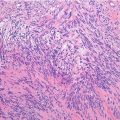Location: Foot, ankle, knee, and upper limb.
Clinical: Slowly growing, moderate size, painless, globose mass.
Diagnosis: On MRI, elliptical, smoothly outlined mass, slightly or markedly hyperintense on T1, white lesion with multiple low-intensity septations on T2, homogeneous enhancement after gadolinium.
Histopathology: Adherent to a tendon or to an aponeurosis, but not to the subcutaneous or to the skin. Firm, globose, well-defined boundaries, capsulated appearance. Round, oval, spindle cells with clear cytoplasm. Nuclei are round, ovoid or elongated, vesicular, with a large nucleolus. Mitotic figures are rare. Cells are arranged in nests surrounded by a fine reticular stroma or rough collagen bands that may give an almost acinar or glandular impression at first glance. Immunohistochemistry shows consistent positivity for S-100, HMB45, MART-1, and MiTF. Molecular findings are characterized by a specific translocation: t(12;22)(q13;q12), with an EWS-ATF1 fusion transcript.
Course and Staging: Local recurrences are frequent when treatment is inadequate due to the not very aggressive clinical presentation. Metastases are late (>6 years) but very frequent in lymph nodes and lungs. Usually, stage II B.
Treatment: Very wide or radical excision with regional lymph nodes.
Immunohistochemical Panel
S100 | + |
HMB45 | +
Stay updated, free articles. Join our Telegram channel
Full access? Get Clinical Tree
 Get Clinical Tree app for offline access
Get Clinical Tree app for offline access

|



